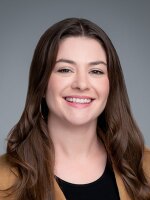On a Monday morning, long lines of surfboards stretched down La Jolla Shores. On them, children practiced — paddle, paddle, paddle! — scooping at the sand, pressing themselves into "seal position," and popping into a crouch.
Outside one blue tent, the boards were taken by a dozen children and young adults somewhere on the wide spectrum of autism, each with their own coach. It was day one of a four-day surf camp.
One silent student laid on their board as their coach moved his limbs into position. When his limbs splayed and wandered, she gently placed them back.

One student, overwhelmed, sat down on his board like a bench. His coach sat with him, and they stared at the ocean.
Another student reached for his coach’s hand and took tentative steps into the waves.
In the shallows, another student sat with their coach and a sand bucket. He let her scoop water and pour it over his hands, getting used to the feeling.
A different student celebrated popping up on his board with an air guitar solo, shouting, “Rock n’ roll!”
Parents started this surf camp 22 years ago.

It’s run by the Autism Society of San Diego and supported by state and county funds.
They accept anyone over age 5 and say they don’t turn anyone away if they can’t pay the $450 fee.
For a long time, they offered 90 spots over five weeks.
But the society’s director, Andrea Korogi, said demand was much greater.
“We were turning away hundreds of people every summer,” she said.
This year, they partnered with Surf Education Academy to double the camp to 10 weeks and 180 spots, and they still have only a few spots left, Korogi said. She dreams of expanding the camp to school breaks and weekends.

The demand reflects San Diego’s unique population.
Nationally, 1 in 36 children are diagnosed with autism. Korogi said in San Diego, it’s 1 in 22.
“Almost every single classroom has at least one individual with autism,” she said.
San Diego offers better services for people with autism than many places in the country, Korogi said. Military families request to be stationed here to access those services, driving up the numbers.
From the blue tent, Andrea Roletter watches her 7-year-old son, Oliver.
Though he can’t read yet, he’s fascinated by books, animals, and service workers like mail carriers and gardeners. He wants to know what they’re doing, why they’re doing it, and when they’re coming back. And he’s obsessed with the water.
“[He] loves the swimming pool, loves the ocean, just lights up around water,” Roletter said.

She said he’s taken swimming lessons for two years now. He learned how to paddle with his hands shaped like ice cream scoops.
But he’s not “water safe” yet.
This camp was created to promote water safety.
Other children with autism are prone to wandering and are often drawn to water, even if they can’t swim.
One study found they’re 160 times more likely to drown than neurotypical children.
Drowning accounts for a staggering 91% of deaths of children under 14 with autism, according to the National Autism Association.
Roletter enrolled Oliver in this surf camp for water safety, for socialization, and for a third, big reason — fun.

“I just want him to have fun. His sister who is a typical child, as one might say, gets to go to all these different camps, and there's really limited options for him,” Roletter said. “So I'm just excited for him to experience summer camp.”
Oliver was excited this morning, too. He got the whole family up at 6 a.m., chanting: “It’s time! It’s time! It’s surf camp!” Rolleter reenacted.
When they arrived, though, he grew a little shy and unsure.
Roletter was not sure how the day will pan out.
“I am feeling hopeful, but to be honest, I don't know what to expect,” she said. “With him, it's a little bit of a hit or miss. He could love it and do it, or he could just be distracted by something and then focus on that, and then a whole day could go by without him actually doing any surfing.”

She said that’s why the one-on-one coaching at this camp is so helpful.
“They need that person who's constantly with them, talking to them, going with their flow, but also paying attention and looking at them,” she said.
Oliver’s coach is Annie Devine. She said he asks a lot of questions: “What are we doing? Where are we going? What are we doing later? Who is this? What is that person doing ... ?”
Coaching these children was a lot more visual and less auditory, she said. She demonstrated more to overcome the communication differences. She tried to figure out how her specific camper communicated and received information and adapted.
It seemed to work.
Before the morning was over, Devine and Oliver rode waves on the board together.

She's confident that by the end of the week, she can get him surfing on his own. She said she had seen it before in similar students.
“It genuinely surprised me when I was paired up with a camper who didn't even want to get off the blanket, didn't want to touch the sand, didn't want to do anything, and was just scared of everything and shy. And by the end of the week, she was surfing,” she said.
Teaching this surf camp taught her something, too, she said. Witnessing the campers made her realize what people can accomplish when they try, and try, and try again.
That morning, Oliver did try, and try, and try again.
Then he ran up the shore, hugged his mother, and asked for a PB&J.





